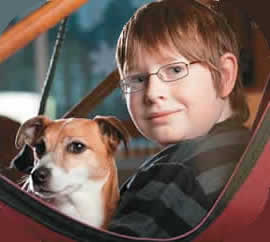Growing Pains
Childhood cancer survivors cope with long-term effects of treatment

Jarred Duncan and Laura Selecki don't remember much about what it was like to have cancer. Duncan was diagnosed when he was 10 months old with a Wilms tumor; Selecki was a little older than 2 when doctors told her family she had rhabdomyosarcoma. Now the University of Michigan Rogel Cancer Center is helping them learn about what they don't remember-and how it will affect them as they grow older.
canDuncan, now 10, has only one kidney, so he's extra careful when he plays sports. It doesn't stop him from bragging about having had the most stitches of anyone in his class, though. He and his mom, Josie, pay close attention to how much protein he eats. And he wonders if the chemo has something to do with why his teeth are so yellow and full of cavities.
Selecki doesn't think too much about having had cancer, but she knows she has to take extra good care of herself. She spends hours each week in ballet classes so she can win a spot in Grand Valley State University's dance program. She understands that she won't be able to have children as a result of cancer treatment, but it doesn't bother her-yet.
"Maybe later it will," said Selecki, 18, of Manchester, Mich. "But I know there are other options."
As the University of Michigan Rogel Cancer Center's Pediatric Long-term Follow-Up Clinic celebrates its 10th anniversary this year, its work has become a model for survivorship care. The clinic evolved out of need and a commitment: Patients should fully understand their risks and how best to address them. Researchers are beginning to take lessons learned from early successes in treating pediatric cancer survivors and apply it to adult populations.
By following childhood survivors closely as part of a national consortium of pediatric cancer research institutions, doctors have learned how to fine tune treatment to prevent many types of unanticipated long-term effects. For example, radiation to the chest, neck and armpit lymph nodes was at one time routinely used for all patients with Hodgkin's disease, said Marcia Leonard, R.N., P.N.P., director of Childhood Cancer Survivorship at the U-M Rogel Cancer Center. But long-term follow-up showed that girls who received radiation to the chest were 35 times more likely to develop breast cancer. Treatment protocols have been changed as a result.
"We've learned a lot from following our patients for many years," Leonard said. "Part of my job is to remind our physicians not just to focus on this minute, but to try to picture the rest of a child's life. We need to inform our patients now of what will happen in the future so they're not shocked.
"Ten years ago when we first started seeing patients in the Long-term Follow-up Clinic, we saw too many 18-year-olds who were shocked to learn of the possibility of infertility because no one had told them that their treatment was likely to cause such problems. Even when we can't do anything to prevent these effects, we at least need to educate our patients about them."

Fleeting Chances
The key to managing the long-term effects of cancer treatment is the same as the key to surviving cancer: early diagnosis. When families are referred to the Long-term Follow-up Clinic three to five years after cancer treatment ends, they meet with a multidisciplinary team of specialists, including Leonard; social worker Peg Woehrle, M.S.W.; child psychologist Catherine Peterson, Ph.D.; dietitian Nancy Burke, R.D.; and potentially an on-call physician.
These visits are important because they can ferret out problems that may not be obvious. Each family or young adult receives a treatment summary including all chemotherapy drugs and doses, radiation port and dose and surgical treatments. More importantly, a care plan specific to the needs of each child is developed. The plan takes into account the child's age, the known risks associated with specific treatments the child received and the individual needs of the child and family.
Beyond possible medical complications, clinic staff members help educate families about the psycho-social impacts of cancer: the long-range effect on siblings; the difficulties in maintaining reasonably priced health insurance after a childhood cancer survivor turns 21; the impact of indulging a child's every wish-or of letting them slack off in school-because of a cancer diagnosis.
Academics are a focal point for the Long-term Follow-up Clinic, particularly if chemotherapy was administered directly into the spinal fluid or if cranial radiation was part of a child's treatment. Peterson intervenes and evaluates school-age children to determine whether a child is having problems with cognitive functioning as a result of treatment. This will help parents work with school teachers to develop individualized education plans to help the child succeed in class.
Research has shown that childhood cancer survivors tend to fall behind in terms of socio-economic status as adults, said Rajen Mody, M.D., an assistant professor of pediatric hematology oncology. They are more likely to be unemployed and to have lower overall graduation rates compared with their peers, he said, which may be because of the cognitive effects of treatment. "That's where early diagnosis comes into play," he said. "Once we identify these problems, we can work with families and schools to lessen the impact, so a child has a better chance to succeed in school and in a future career as an adult."

Surviving into Adulthood
The transition to adulthood is difficult for any kid, but even more so for childhood cancer survivors. Health insurance often comes at a premium when cancer is considered a preexisting condition. Even finding a primary-care doctor who is willing and able to provide care for a survivor can be difficult, Mody said.
Laura Selecki is excited about becoming more independent and going to college-and a little scared, as any 18-year-old is. She knows she has a higher risk of developing leukemia, but she's not too worried. Her mom, Carol, said her family has been discussing concerns related to her diagnosis, especially as she's grown into a young woman.
"She's always taken things as they come," Carol Selecki said. "We probably worry about it more than she does. I don't think it's a big concern for her. She's always had the attitude that she's going to make the most of her life."
The Long-term Follow-up Clinic continues to see patients, even as adults, to ensure they receive the care they need. Generally, patients are seen in the clinic for 10 years after the end of cancer treatment-or 15 years, if a blood stem-cell transplant was involved. The clinic's oldest patient is 43.
Often, it isn't until patients start coming to the clinic as young adults without their parents that they start asking questions of their own, Leonard said. Starting college, getting married, trying to have children and other milestones often prompt questions patients didn't realize they had. And it's still not well known how natural aging affects childhood cancer survivors.
But with time, researchers and health-care providers hope to have better answers.
"It's not uncommon for children with adverse cancer treatment effects-for those who aren't quite as tall or who don't do quite as well in school or who are infertile-to be told that they should just 'be happy that you're alive,'" Leonard said. "We recognize that these children need a good quality of life, too. It's not just enough to survive."
Getting Tested
Researchers believe 40 to 50 percent of children treated for cancer are at risk for long-term cognitive side effects . . . side effects that affect thinking and learning The Four W's.
1). Who should be tested?
All children who receive cancer treatment that affects the brain should be tested. This includes children who have had cranial radiation or intrathecal chemotherapy, particularly kids treated at a very young age. "Not all children will have these problems, but it's better to know early," said Marcia Leonard, director of the U-M Pediatric Cancer Survivorship Program.
2). When should you be tested?
At major developmental steps: 18 months to 2 years old; kindergarten; third grade; start of middle school; start of high school; high school graduation.
3). What are the signs?
Problems can be subtle and may not start showing until middle school or later. Warning signs include a sudden drop in performance between elementary school and middle school; difficulty completing homework in a reasonable time frame; drop in motivation or frustration over homework.
4). Where can we get help?
The U-M Long-Term Follow-Up Clinic provides neuropsychological testing referrals for appropriate patients. Oncologists will refer patients to the follow-up clinic when they are three years out of treatment.
Parent to Parent Advice
Be your child's advocate.
You're responsible for your child's best interests. Be patient and persistent to get the help you need. If the Individualized Education Plan isn't leading to progress, ask for a meeting.
Know your rights.
Childhood cancer survivors are covered under the Individuals with Disabilities Education Act, which requires that public schools provide free and appropriate education to all children between the ages of 3 and 21. In addition, the Rehabilitation Act of 1973, Section 504, requires all federally funded educational institutions to provide accommodations for students with certain physical or mental impairments.
But, be nice.
You know the old saying about flies and honey. Same thing applies with teachers and coffee.
And, meticulous.
Take notes at your IEP meeting. Follow up if you think something has been omitted from your child's plan.
Find a way to be a presence in your child's school.
For Lissa Strodtbeck, that meant volunteering at school. If that isn't possible, then make a point to pick up your child from school. Take the opportunity to chat with teachers to find out what's going on and how you can help work on concepts at home.
Make playtime a priority.
"Kids don't care about learning disabilities, said Strodtbeck, who has two other children, Ethan, 9, and Gillian, a newborn. "They demand that Isaac come up to a certain level, and he responds to that."
Continue reading the spring, 2009 issue of Thrive
